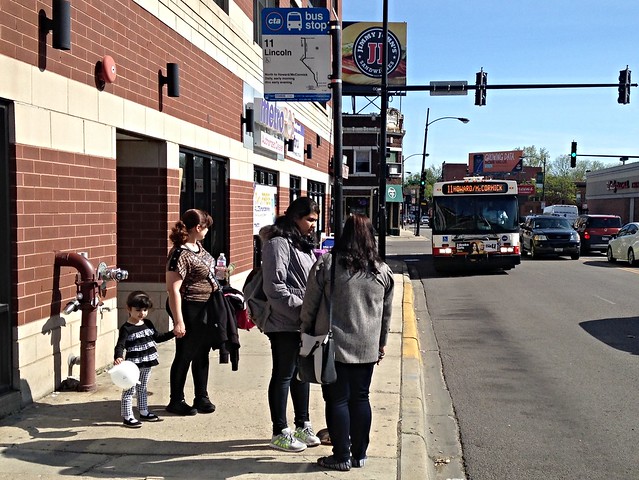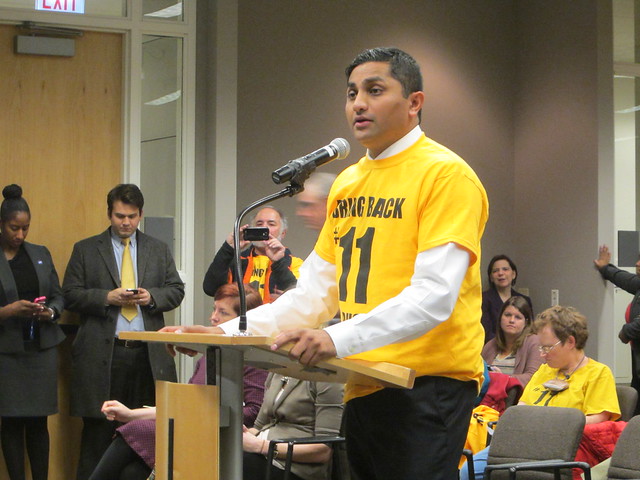[The Chicago Reader recently launched a new weekly transportation column written by Streetsblog Chicago editor John Greenfield. This partnership allows Streetsblog to extend the reach of our livable streets advocacy. We syndicate a portion of the column on the day it comes out online; you can read the remainder on the Reader’s website or in print. The paper hits the streets on Thursdays.]
Community activists who lobbied for years for the restoration of the Lincoln Avenue and 31st Street bus routes rejoiced last November after CTA president Dorval Carter Jr. made a surprise announcement that the routes would be coming back on a trial basis in 2016. The CTA board voted earlier this month to relaunch each of the bus routes as a six-month-long test to determine whether there's enough ridership to bring back the lines permanently. But transit advocates say the way the agency devised the program's bus schedules ensures the pilots will fail.
While the restored #11 Lincoln line will debut on June 20, the #31 bus won't return until September. South-side activists say that will undermine the pilot because summer ridership towards 31st Street Beach won't be counted. Worse, residents say, both bus lines will run only on weekdays between 10 AM and 7 PM, so they'll be useless for morning rush-hour commutes. And while the Lincoln buses will run every 16 to 22 minutes, 31st Street buses will arrive only every half hour.
"It looks like it's set up to fail," Tom Gaulke, pastor of First Lutheran Church of the a and member of the Bridgeport Alliance, a social justice organization, told DNAinfo last week in regards to the #31 bus. "It feels like a bit of a slap in the face." Commenters on social media were also dismissive of the limited Lincoln bus schedule. "No availability on the weekend or morning hours for commuting doesn't appear to make this a true 'test' of whether there is demand for the #11 bus," north-side resident Brendan Carter wrote on Facebook.
The CTA says, on the contrary, that the schedules were actually devised to make sure the pilots succeed.
So how did it come to this?
Back in 1997 the CTA, citing low ridership, cut the #31, and residents have been trying to bring it back ever since. In October 2011 the Bridgeport Alliance and the Little Village Environmental Justice Organization joined forces to lobby for restored service, which led to the CTA's addition of a section of 31st Street in Little Village to the existing 35th Street bus route in 2012. But advocates continued to push for full reinstatement of the #31.
The #11 route was shortened during a round of CTA bus cuts in 2012 that eliminated the portion between the Brown Line's Western station and the Fullerton el stop while preserving the stretch between Howard Street and the Western station. At the time the CTA recommended commuters take the train, which generally parallels Lincoln, as an alternative to the bus, but the el stations are as far as a half mile from Lincoln.
Alderman Ameya Pawar of the 47th Ward spearheaded an effort to win back full service along Lincoln. He was joined by other local elected officials, chambers of commerce, and residents—especially seniors. The retirees showed up in droves to CTA hearings wearing yellow bring back the #11 bus T-shirts to testify about how the service had formerly functioned as a lifeline, transporting them to grocery stores and medical appointments.
Since north-siders are often viewed as squeaky wheels who get more than their fair share of resources, Pawar realized he'd had better luck achieving his goal if he joined forces with south-side advocates to lobby for an equitable restoration of bus service. (Lincoln Park alderman Michele Smith and Bridgeport alderman Patrick D. Thompson, who also advocated for restoring bus service, didn't respond to interview requests.)
In April 2015, Pawar reached out to the Bridgeport Alliance, as well as to south-side groups Coalition for a Better Chinese American Community and Southsiders Organized for Unity and Liberation, to form the Crosstown Bus Coalition. Last fall, the partnership proved its mettle when the CTA's Carter agreed to restore the routes to test their viability.






